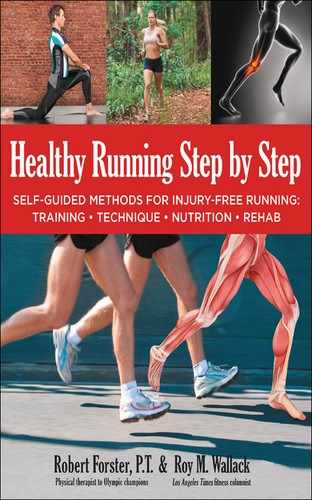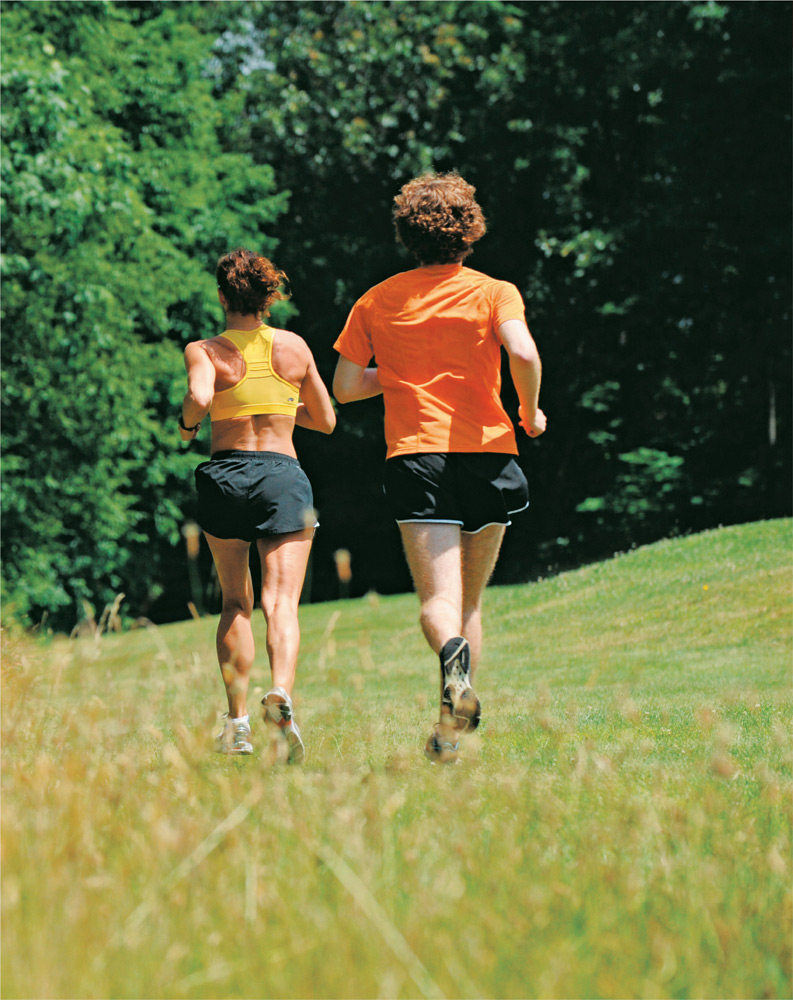
Introduction
Nothing’s sadder than a runner who can’t run. At any one time, there are a lot of sad runners. Some studies say that 50 percent of runners every year get injured enough so they can’t run, while others say it’s as much as 80 percent.
I was sad and desperate the day I walked into the Santa Monica, California, office of Forster Physical Therapy, the go-to fix-it shop for West L.A.’s runners, cyclists, and adventure racers. It was April 1999, 2 weeks before the Boston Marathon. I’d planned to run it, had purchased a plane ticket months before, but had a problem: I’d only done a total of 20 miles (32 km) in the previous 4 months because of intense, searing pain in my left hip when I ran. During that time, I’d already gone to several physical therapists, who typically had me do a series of pelvic stretching exercises; these did not solve the problem at all.
But Robert Forster, a PT-to-the-stars known for treating some of the biggest names in running, tennis, and other sports, starting with Florence “Flo-Jo” Griffith Joyner and Jackie Joyner-Kersee at the 1984 and 1988 Olympics, approached my hip pain differently. He didn’t mention stretching at all (that would come later). He had me jog up and down the hallway for 10 seconds. Then he said this:
“You have excessive side-to-side body sway that is torquing your hip; that’s probably what’s causing the pain. To stop the sway, try swinging your arms vertically alongside your rib cage, not sideways across your chest.” Until that moment, I had no idea that my arms did not swing vertically.
Forster wasn’t done yet. “As for your crazy fantasy of finishing a marathon on no training, you have no hope whatsoever of doing that unless…”
“Unless what?” I said.
“Unless you completely change your form—right now. Listen and repeat after me: ‘High knees, proper arm swing, and rapid turnover. This will shorten your stride and force your feet to land under the center of your body. Run softly. No heel strike.’ Your goal: Baby your body and reduce the impact on your joints by distributing the load over more, smaller steps. Forget long strides: You fly through the air farther, crash down hard on your heel, and put more leverage and stress on your muscles and tendons, leading to injuries. If you don’t baby your untrained muscles with short strides in Boston, you’ll flame out long before you reach the finish line.”
Then Forster gave me a visual: “You want to be like the Road Runner, legs underneath you, circling in a blur, feet barely touching the ground. Beep-beep!”
Completely change my form? Short strides? Vertical arm swing? Baby my body? I’d never heard any of this before. Hardly anyone had—it was a decade before Born to Run put the spotlight on running injuries and the relationship between them and poor running mechanics. But unbeknownst to me, what Forster described was the way the best runners in the world ran, and that’s who he had learned it from, literally starting the day that he graduated physical therapy school.
Studying with a cutting-edge team of running-biomechanics experts at Centinela Hospital Medical Center in Los Angeles, Forster quickly became the running expert at the world-renowned Kerlan-Jobe Clinic, which took care of sports teams, such as the Lakers, Kings, and Rams. Forster then traveled to international running events around the globe with a young, soon-to-be-famous UCLA coach named Bob Kersee as they trained a team that would go on to win forty-six medals at the next eight Olympic Games. When Forster opened his own practice in 1983 (as well as his Phase IV Scientific Health & Performance Center in 2003), he applied the same rules to regular folks that he learned from the elites: Good form and gradual adaptation make for a fitter, stronger, faster, and less-injured athlete.
When I left Forster’s office that April morning in 1999, armed with my Road Runner imagery, I headed right to a treadmill at my gym. In minutes, I received the most pleasant shock of my life: no pain in my hip while running for the first time in years!
Suddenly, my Boston experiment didn’t seem so impossible. The hardest part was done! Over the next 10 days, I logged 34 training miles (54.4 km), maxed out with a 13-miler (20.8 km), cross-trained on the elliptical, and flew east. From my first steps at the 103rd Boston Marathon, I religiously stuck to my little Road Runner strides. I was too afraid not to. As Forster had advised, I didn’t push it. I focused on my pendulum arm swing and little pin-wheeling stride. Through 10, 15, 20 miles (16, 24, 32 km), it worked perfectly. I climbed Heartbreak Hill without a twinge. Then, overexcited by my success with my new form, I forgot about it. Forster’s advice was out the window as I lengthened my strides and flung my feet way ahead of my body on the long gradual downhill into mile 24. That’s where the chaos began, as it had to. The last 2 spasm-wracked miles weren’t pretty, but I stumbled across the finish in 3:56—to the amazement of my friends, who’d all bet I’d be on the bus by mile 16.
I was amazed, too. Just finishing that day changed forever how I thought about running. If shorter strides and a vertical arm swing was this easy on your body in a marathon, imagine how much healthier and less injured you’d be if you ran this way over a lifetime. And you’d probably run faster, too. If I’d had more time to train, I would have shattered my personal record.
When I came home and told Forster that, and thanked him endlessly for what he’d done for me, he slapped me on the back.
“Exactly! Performance, injury prevention, and injury rehab are all linked,” he said. “You can’t separate them! That’s what I’ve been preaching for years!”
Forster believes that you can’t just fix an injury in isolation. When I came in with my hip injury, it wasn’t my hip that was causing the problem, it was a bigger-picture issue. “A good PT isn’t just an auto mechanic who fixes a worn part,” he says. “You have to figure out what’s causing the wear. So he also has to be an investigator who hunts around and finds the root of the problem upstream. Fix the cause, and you get fewer injuries and less downtime—meaning better training and better results.”
This is why Forster takes a holistic view of addressing running injuries, and why we divided Healthy Running Step By Step into two parts:
Section 1:
A big-picture game plan that can stop injuries from happening in the first place, starting with a time-tested “Periodization” training plan to gradually adapt your body to race distances while remaining injury-free, and a full-body assessment of your flexibility, strength, posture, balance, and training history.
Section 2:
A pain-relief rehab program that will nurse you back to full strength with a graduated series of adaptations. Over the years, Forster has designed a template of actions for every major running injury that you will see here as a large grid, labeled Self-Diagnosis and Rehab Matrix.
Most PTs ignore section 1 and skip right to section 2. Forster addresses section 1 first to improve running mechanics, train to prevent injuries, keep runners out of rehab, and stop the problem from happening again.
Assessment, Prevention, and Rehab
In an ideal world, you wouldn’t wait until you get injured to fix your problems. That inevitably leads to re-injury and a return trip to rehab. To prevent the physical therapy yo-yo, you’d “fix” your injuries before they even happen, starting with learning proper form (such as eliminating arm cross-chest swings and heel striking). Another key chapter discusses balance and posture, which get corrupted over the years by a host of stresses that wreck side-to-side symmetry. Everyone, whether they know it or not, has certain mechanical issues, such as leg-length discrepancies (a widespread problem that affects most people); previous traumatic injury weaknesses and dominant-/weak-side body imbalances; joint and collagen degeneration from age or disease; and medicine-induced deterioration to joints and collagen.
This is where weight training and stretching come in. Covered in substantial chapters, they are each necessary to build and maintain speed, ensure healthy running again, and help keep the body aligned and symmetrical.
That’s especially important for runners, because running as we practice it in the modern world magnifies the smallest misalignments and imbalances. “If you can imagine that humans are ‘primal’ beings who evolved into our current form over a few million years, you have to recognize that exercise as we know it today isn’t what hunter-gatherers did,” says Forster. “They didn’t go 22 or 23 hours without moving, then bolt off on a heart-throbbing run for 45 minutes, like we do today. They did a variety of stuff—long, fast marches to chase big game, short sprints to dodge tusks or spears, and slow walking to gather berries. Their bodies were strong and their tendons and ligaments hardened by constant movement, so misaligned joints could handle the stress. But when subjected to daily bouts of intense, repetitive motion, like modern running, stress and wear are accelerated—and runners have to come see people like me.”
In other words, modern running is an inherently risky activity. Add a work ethic that encourages you to push hard all the time without proper rest and recovery, and the sport almost wills you into overtraining, a condition in which muscles and joints receive no time to heal after hard workouts. At best, most runners I meet are always somewhat fatigued, making them vulnerable to illness and injury. It’s no surprise that most of them get sick or hurt.
That’s why following a classic Periodization training schedule is so important. Periodization, in case you haven’t heard of it, is a training schedule used by the world’s best strength and aerobic athletes for decades to gradually and safely ramp up your fitness. It incrementally increases your running volume to build your base, backs off every few weeks temporarily to allow recovery, and then adds more strength and speed work to sharpen you up for your 10k or marathon.
If you get Periodization right, it eliminates overtraining and the injuries that result from it. But if your running program is designed by your daily whim and allowed to get stale without intelligent progression, you will end up burned out, injured, or both.
Other chapters in section 1 also tell you how to identify signs of overtraining, so you can avoid it, and provide a tutorial on postexercise recovery techniques such as icing, compression, and elevation, so that you can come back next time even stronger and faster.
The instructions in section 2, Healthy Running Step By Step’s rehab program, focus on the “big 5” running injuries: IT band syndrome, Achilles tendonitis, shin splints, plantar fasciitis, and hamstring strains.
For each of the five injuries, Forster developed a Self-Diagnosis and Rehab Matrix that asks you to assess your own injury and its severity, with an 8-week time frame for the worst ones. It then takes you through your rehab step-by-step, from the bread-and-butter physical therapy protocol of PRICE (protection, rest, ice, compression, elevation) to simple range-of-motion movements, strengthening and stretching exercises, cross-training activities, and finally, regular running and hill work.
The matrix is so comprehensive and logical that in many cases you will be able to rehab yourself. If you choose to visit a PT, the chapter information and matrix will educate you well enough to have a say in your treatment.
SUMMARY: THINK LONG-TERM
We know that most readers of this book will immediately turn to the injury rehab matrix to get pain relief and a quick recuperation to get back to their regular running routine. But they shouldn’t forget what caused the injury in the first place.
“Early in my career, I would start at the injury rehab matrix when dealing with patients,” says Forster. “But then I realized that fixing mechanics and creating a sound training program, with attention to proper mechanics, stretching, strengthening, and diet, are more important, almost preventing the need for the matrix.” With this philosophy in mind, we laid out the book by placing preventive, long-term measures up front.
Injuries are a risk in all sports and seemingly a part of the job description for runners, who have chosen a strenuous, repetitive activity that has a tendency to exaggerate leg-length discrepancies, old injury sites, and all biomechanical inefficiencies to the point where they create injuries. Forster, educated by decades of treating thousands of patients, from Olympians to 80-year-olds, has learned that the most important aspect of treatment is a big-picture view that uncovers (and fixes) the causes of the injuries so they won’t come back. That’s why we spend a lot of time describing a joint-friendly running form and an organized, gradual, and safe Periodized training plan, augmented by regular stretching and strength work that helps your body retain symmetry and buttress weak spots. With this approach, most running injuries are avoidable. If you’re not injured yet, make section 1 your bible.
If you do get injured, it is important to participate in rehabilitation with a long-term solution to the problem in mind. Otherwise, you’ll soon be riding the rehab yo-yo back to your PT. Study the specific injury’s exclusive Self-Diagnosis and Rehab Matrix. Each one lays out a schedule for full recovery. Don’t rush it. Spend your downtime wisely by reading about the importance of improving posture, strength, and flexibility, all described in the following pages. Then get a head start on those tasks while you rehabilitate your whole body, keeping in mind the big picture of health and performance.


